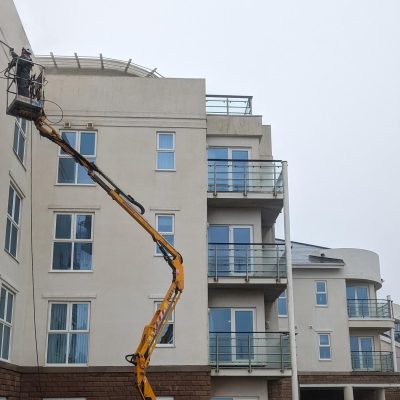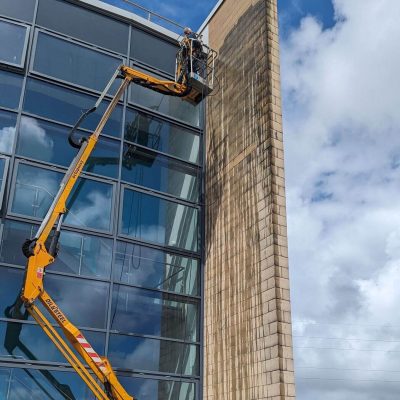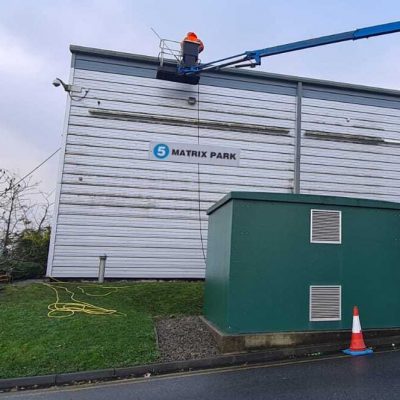Working at heights can be extremely dangerous, which is why having proper fall protection is absolutely essential. A fall protection system refers to the equipment and practices put in place to prevent workers from falling or reducing the consequences of a fall while working at elevated heights.
There are a few key elements that make up a comprehensive fall protection system:
- Anchor Points: Secure points to attach lifelines, lanyards or deceleration devices. Anchor points should be able to support at least 5,000 pounds per worker attached.
- MEWP Body Harnesses: Worn by the worker and used to distribute fall forces over the thighs, pelvis, waist, chest and shoulders. Harnesses have an attachment point between the shoulder blades for connecting a lifeline or lanyard.
- Lifelines: A flexible cable or rope used to connect a worker’s harness to an anchor point. It limits free fall distance to 2 feet or less.
- Lanyards: A flexible strap with self-locking snap hooks at each end for connecting to a harness and anchor point. Shock absorbing lanyards reduce fall arrest forces.
- Rope Grabs: Mobile fall arrest devices that glide along a lifeline and automatically lock in place during a fall. Used for vertical lifelines.
- Guardrails: A barrier erected along exposed edges to prevent workers from falling. Top rails should be 42 inches high and able to withstand at least 200 pounds of force.
- Safety Nets: Installed below the walking/working surface to catch workers in case of a fall. Minimum clearance is 10 feet.
- Warning Lines: Designated areas at least 6 feet from an unprotected edge. Workers are not allowed in this area without being tied off.
- Controlled Access Zones: Marked off areas where certain work may take place without conventional fall protection, provided only authorised workers have access.
- Fall Restraint Systems: Equipment that prevents workers from reaching an unprotected edge, such as harnesses and very short lanyards that keep workers from getting close to a fall hazard.
- Safety Monitoring Systems: The use of a competent person to monitor the safety of workers in place of conventional fall protection when performing specific types of work with proper training and rescue procedures.
The type of fall protection system used depends on the nature of the work being done and the workspace environment. Employers must assess fall hazards and equip workers with adequate protection based on applicable government standards.
Fall Protection Standards
In the UK, the use of fall protection systems is regulated by the Work at Height Regulations 2005. This law requires employers to ensure:
- All work at height is properly planned and organised
- Those involved in work at height are competent
- Appropriate work equipment is selected and used
- The risks from fragile surfaces and falling objects are properly controlled
- Equipment for work at height is properly inspected and maintained
The regulations state that collective protection measures, such as guardrails and nets, must be considered first before implementing personal fall protection, such as harnesses. Ladders should only be used for light, short duration work. Fall arrest systems are generally required when working over 2 metres, although there are some exceptions.
Fall Protection for MEWPs
MEWPs, or Mobile Elevating Work Platforms, are pieces of equipment that provide temporary working surfaces at height. This includes scissor lifts, boom lifts, cherry pickers, vertical lifts and more. Proper fall protection must be worn while using an MEWP.
Although the platform itself acts as edge protection during use, workers are still at risk for potential falls when entering, exiting or transitioning around the equipment. Sudden movements or improper use can also throw operators off balance.
2 main methods of fall protection can be used with MEWPs:
- Fall Restraint Systems: These keep the worker inside the platform using a harness or belt connected to an anchor point. It allows full mobility within the platform but prevents the worker from being ejected or exiting the platform.
- Personal Fall Arrest Equipment/Systems: These include a full body harness and a lanyard or self-retracting lifeline that can arrest a fall from the platform. It is used as a backup but should not allow the worker to exit the platform.
It is essential that fall protection be worn 100% of the time when using an MEWP. This includes keeping it on during all stages – entering, moving, working and exiting the platform. Proper training on the equipment, including emergency procedures in case of a fall, is also critical.
Setting Up a Fall Protection System
An effective fall protection program involves more than just purchasing the right equipment. It requires careful planning, training and ongoing vigilance to keep workers safe on the job. Some tips for setting up a proper fall protection system:
- Identify all fall hazards – Conduct a hazard assessment of the site to locate potential areas and tasks that pose a risk of falling. Inspect the area for unstable surfaces, unprotected edges, holes or slopes.
- Select appropriate equipment – Choose fall protection suitable for the type of work, environment, potential fall distance and number of workers. Customise the system based on site-specific factors.
- Calculate total fall clearance – The required clearance below the working surface depends on the stopping distance of the fall arrest system, lanyard length and height of the worker. There must be sufficient clearance to prevent striking an object below.
- Establish sturdy anchor points – Anchor points for lifelines, lanyards, retractables or fall restraint systems need to support at least 5,000 pounds per worker attached. Choose structural beams, girder ends or purpose-built approved anchors.
- Train all workers thoroughly – Employees must understand proper use of fall protection equipment, inspection procedures, rescue protocols and how to calculate fall clearances. Qualified personnel should provide hands-on supervision.
- Inspect equipment diligently – Check harnesses, ropes, lanyards, carabiners, anchor points and all components before each use. Remove damaged items from service immediately. Maintain records of inspections.
- Follow safe practices – Enforce safety policies such as using 100% tie-off techniques, prohibiting extra slack, keeping lanyard length to a minimum and avoiding improper rigging that can increase free fall distance.
- Rescue procedures – Have specific rescue plans in place for prompt retrieval of any worker trapped in a fall arrest system post-fall to avoid suspension trauma. Conduct regular drills.
By following these guidelines, employers can develop an effective, compliant fall protection program adapted to their unique workplace. Taking steps to properly plan, install, use and monitor fall protection systems will help prevent serious injuries due to falls from height.



